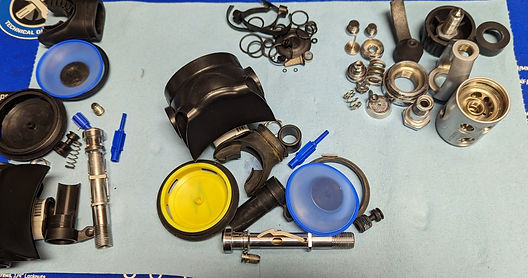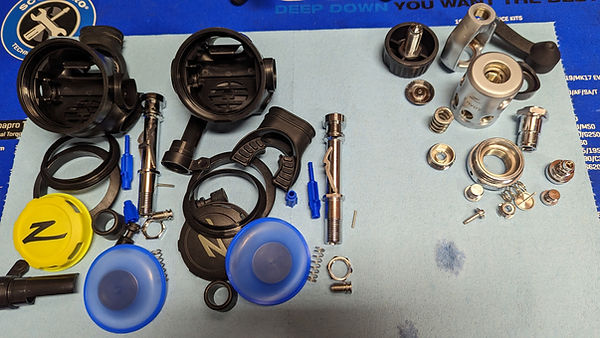
WHAT'S INVOLVED IN A REG SERVICE

Regulator manufacturers all recommend regular servicing, usually in two- or three-year (or 100-200 dive) intervals depending on model. Some manufacturers also recommend inspections on non-service years. But what happens when you bring your regs in for service or inspection?
Full Service (Annual Service)
A full service (commonly called an annual service due to the frequency it’s done) involves completely disassembling a regulator, cleaning it, replacing o-rings and seats, then reassembling and testing. Each manufacturer has schematics and repair guides for each model of regulator. The repair guide walks you through disassembly and reassembly of each model. Even regulators I’m incredibly familiar with and have serviced over and over, I still open the repair guide for easy reference and have the schematic in front of me.
Each regulator also has a specific parts kit for it. The parts kit has all the internal pieces that the manufacturer recommends replacing every service. This includes all the o-rings, seats, and assorted other bits, depending on the regulator. A parts kit is needed for each stage of the regulator (first, second and alternate) so a regular configuration single tank set of regs would need three parts kits. Depending on the manufacturer some kits can be used for multiple models, others can be used only for a specific one. The parts kits are purchased directly from the manufacturer and most manufacturers will not sell them to individuals; only companies that have techs they can verify have taken their specific service training within their required intervals.
Once I have my schematics, kits and reference guide, the first thing I do when a regulator comes in for a full service is a quick inspection to see if anything is wrong with them before I start. I’ll hook the regs up to a tank, pressurize it and submerge it and look for bubbles. Then I'll check the intermediate pressure, or IP. Most regulators have their IP set to between 125-145, depending on the make and model.

Once I’ve determined if there are any pre-existing issues with the regulator, I’ll take a few pictures of it to ensure that when I reassemble I have it set up exactly how it was before. Then I get to the actual servicing. First up is taking all the hoses off the first stage and removing the second stages from their hoses. The hoses then get put aside... I usually clean those last. Once I have just the first stage and two second stages alone and separate from all the hoses the full disassemble begins.

The regulator and all its internal components come completely apart. As I'm disassembling, I'll separate the o-rings, seats, and changeable parts from the rest of the reg. Some parts of the regulator are tightened to a torque setting so must be disassembled with the aid of a vise and a special tool to prevent damage to the reg while it is in the vise. Many regs also have special tools unique to them. Others just use standard tools.



Once the reg is completely apart, I go through and do a gross clean and inspection of the parts. The gross clean simply involves using a brass brush to brush off corrosion built up on metal parts. I’ll take photos of any parts with excessive corrosion as well, both because I love to see the before and after, and to show people how much corrosion was on their gear, in an effort to help encourage better rinsing and maintenance. While I’m doing this, I’ll also inspect each part for damage. It is uncommon for there to be internal damage on a set of regs, but it does happen.
Once all the parts are dry, I’ll re-inspect them. I’ll check to make sure everything is actually clean, and any corrosion is now gone. If it’s not, I’ll reclean that specific part. Then I’ll take photos of the cleaned parts, both for my before and after, and to keep a record of their cleaning.

Then finally it’s reassembly time! When I’m reassembling, I'll go through and add all the o-rings to the stage I’m working on first. Then I’ll lubricate the o-rings that need it. Once all o-rings for the stage are lubricated and in place I'll reassemble everything hand tightened to start. When I reach a point that I cannot progress until a previous part is properly tightened, then I’ll go through and torque everything to its required specifications, then continue on the assembly.


After all the stages are reassembled, I'll start on the hoses. For LPI hoses there is just one o-ring where they screw into the first stage. Regulator hoses have an o-ring where it screws into the first stage, as well as where the second stage screws onto it. High pressure, or gauge, hoses have an o-ring connecting them to the first stage, as well as two small o-rings where the gauge connects to the hose. These two o-rings are on either side of a high-pressure swivel; a small metal tube that allows you to twist your gauge around while underwater.
All the o-rings on the hoses need to be replaced, and the metal at either end of the hose needs to be cleaned. Usually, the high-pressure swivel needs to be cleaned or even replaced as well. If the gauge sits in a plastic or rubber gauge boot or as part of a console there is often a large amount of corrosion build up on the back and sides of the gauge. This will need to be cleaned as well.

When all the hoses and gauges are complete, it’s time for the final reassembly and adjusting. The regulator will have all the hoses and stages attached how they were initially (unless requested otherwise). At this point I'll just hand tighten all the hoses in case there is an issue with anything and I have to disassemble them again. When everything is connected I’ll hook the regs up to a tank and an IP gauge and pressurize it.
Adjusting regulators varies a bit based on the manufacturer, but you’ll always start with the first stage, and set the IP to the range recommended for that model. Once that is set, you’ll move onto the second stages. For the second stage, there is a preliminary adjustment of the lever height done while assembling the regulator, then during this pressurized adjustment, I test and fine tune adjust. Once that is done, I’ll check the opening effort, or cracking effort, of the regulator. This is essentially how hard you must breathe to get air. It is represented in mbar or inches of water. Again, this will vary based on the make and model, but generally a primary second stage is set to around 0.8 - 1.6 mbar, and an alternate is set to around 1.0 - 2.0.
Once everything is adjusted and tested, I’ll spend a few minutes purging and releasing air from both second stages. This cycles the regulator a few times to ensure everything still stays in adjustment after use. After doing this a few times, it’s fairly common to have to re-adjust the regulator, as the new seats I just installed start to get worn in.
After this final adjustment, I can go ahead and tighten the hoses, replace any hose protectors and re-install the mouthpieces. The last step is a quick submersion test, or bubble test. I put the full set into a tub of water (while pressurized of course) and check for any leaks. Assuming that goes well, the regs are finally done! Depending on the make and model and cleanliness of the regs this entire process usually takes between 2.5 - 3.5 hours, however for particularly corroded and nasty regs it has taken me much longer. Even if you rinse your regs extremely well, or you’re not actively diving, you should still get your regs serviced every two years as o-rings deteriorate over time, even when they’re just sitting.

Inspection
On years you’re not getting your regulator serviced, or before a big trip, it is a good idea to get your regs inspected. The first step of an inspection is to connect the regulator to a tank, pressurize it, and do a bubble check by submerging it in a tub of water. After the bubble check I’ll check the IP. Again, the range should be between 125-145, depending on the make and model. If the IP is off but stable, I'll adjust it. If it is continuously creeping up, or the regs were bubbling underwater then they fail the inspection and need to be fully serviced. Assuming they pass both of those tests, next I’ll check the OE. Again, if the OE is slightly off, I’ll adjust it, if it is totally off then the reg will need a full service.
From there, I’ll go through and check the venturi lever and adjustment knob, if the reg has them. I’ll ensure both turn smoothly and there is no corrosion holding them in place. Then I'll do a corrosion check for the inlet filter and check the exhaust valve and mouthpiece. Finally, the hose protectors get pulled back and the hoses themselves get examined.
Full services and inspections are an especially important part of your overall regulator health. A full service is the mandatory tune up after it’s been a while, and inspections are a great way to make sure your regs are in good shape and ready to dive, before jumping in the water. Neither of these replaces your regular maintenance and care of your regs (rinsing namely), but instead assists to make your regs last as long as possible and ensure your reg performs well underwater.
